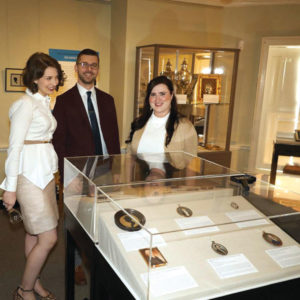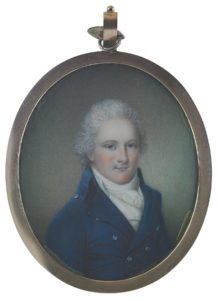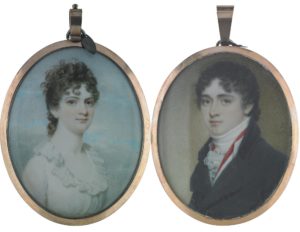A Perfect Profile: Miniature Portraits, Silhouettes, and Landscapes of Early Annapolis
by Rachel Lovett, Curator & Assistant Director,
Hammond-Harwood House Museum, Annapolis, Maryland
The Hammond-Harwood House was pleased to welcome members of the Decorative Arts Trust for tours and workshops during the Spring 2019 Symposium. Participants were able to tour the special exhibition A Perfect Profile, which considers early likenesses, such as silhouettes, miniatures, and landscapes, as a precursor to modern-day social media (Figure 1).
When you build a profile on social media, you select an image of yourself and a background picture to provide insight into your identity. In essence, the profile is the outside face you present to the world. Early Americans were no different, as they sought out ways to express their identity through likenesses. By 1803, the Annapolis-raised artist Charles Willson Peale remarked, “Profiles are seen in nearly every house in the United States of America.”
Silhouettes, also known as profiles, were the most common and inexpensive way to capture a person’s image, with itinerant artists seeking out commissions from farming communities to urban centers. Prior to photography, the lines of these small black-and-white cut paper outlines were seen as symbolic of a person’s character, at a time when the new nation was defining what selfhood and citizenship meant. Profiles were an affordable alternative to oil painting or miniatures, making this medium the first likeness to be democratized across boundaries of race, class, religion, and gender. The miniature portrait, typically watercolor on ivory and enclosed in an oval case, often contained hair from the sitter on the reverse. These small keepsakes were shared with loved ones on special occasions and were frequently worn as jewelry.
Miniaturists were centered in urban areas and relied on a good social network for commissions. Wealthy Annapolitians sent the promising artist Charles Willson Peale (1741–1827) to London in 1765 to train under expat American painter Benjamin West. Upon his return to Annapolis in 1769, Charles began painting miniatures and taught his brother James (Figure 2) to execute renderings in this format.
The exhibition looks beyond the city’s gentry to highlight the full breadth of Annapolitan history and culture. Complex narratives on class, slavery, disabilities, gender, addiction, family disputes, and religion emerge as 18th- and 19th-century Annapolis is unearthed from primary documents. Some of these stories would have appeared in the newsfeed of Annapolis gossip. For example, the controversial marriage of the youngest daughter of the class-conscious Ogle family is represented in a silhouette. Other reports were carefully curated out of the public eye, like the shooting death of an enslaved man for accidentally trespassing on Wye Island as told through miniatures of his master, Edward Lloyd V, and Lloyd’s neighbor, John Beale Bordley.
Artist Robert Field depicted an attractive couple filled with optimism for their future life together in the miniatures of Frances and Richard Loockerman, commissioned for their 1803 marriage (Figure 3). Unknown to Frances during their courtship, Richard’s vices soon became apparent, including rampant gambling and struggles with alcoholism that would cause his demise in 1834. Through their miniatures, the young couples’ social aspirations as members of the city’s 19th-century elite are juxtaposed against a harsh reality.
The exhibition is on view at the Hammond-Harwood House Museum until December 31, 2019. The museum is open every day except Tuesday, with tours on the hour from noon to 4pm.
NOTES:
1 Charles Willson Peale, The Selected Papers of Charles Willson Peale and His Family, vol. 1, Artist in Revolutionary America, 1735-1791, ed. Lillian Miller et al. (New Haven: Yale University Press, 1983), 916.
2 Asma Naeem, Black and White Silhouettes Then and Now (Princeton: Princeton University Press, 2018), 4.
3 Susan Strickler and Tamar Krichevsky, Intimate Keepsakes American Portraiture and Miniatures (Manchester: Currier Museum of Art, 2018), 4.
4 Robin Jaffee Frank, Love and Loss American Portrait and Mourning Miniatures (New Haven: Yale University Press, 2000), 5.
5 Dale T. Johnson, American Portrait Miniatures in the Manney Collection (New York: Metropolitan Museum of Art, 1990), 21



